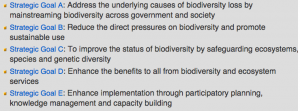Next June 16th, I will be speaking at an event being put together in Warsaw by the Polish chapter of the European Union’s Business @ Biodiversity Platform and since Biodiversity has not been covered in much depth in these posts to date, I thought I would dedicate the next few posts to the topic and the issues it raises for business.
Biodiversity, the basics
According to an American group, The National Wildlife Federation, Biodiversity or Biological diversity is the variety of life on our planet. According to them, estimates of the number of different species range from 3 to 30 million although most are insects and tiny organisms.
In parallel with its concern about climate change, the United Nations also established a Convention on Biodiversity in Rio in 1992 and the Convention has 196 states that have agreed to its terms as well as the United States which signed the agreement but has not yet ratified it in the U.S. Senate. The full text of the convention is available here and so far there have been 12 international conferences of the parties in a number of cities around the world with subsequent agreements and targets named after specific cities.
 The convention is presently pursuing its strategic plan for the period 2011 – 2020 with twenty targets grouped in five areas.
The convention is presently pursuing its strategic plan for the period 2011 – 2020 with twenty targets grouped in five areas.
The targets are tremendously ambitious and essentially call for the world to stop damaging its fisheries, forests, wild growing plants and endangered species by 2020 and for all of the parties (countries) to have biodiversity strategies in place by 2015.
Fisheries, for example, is target number 6 and there is growing evidence that at our current rate of fishing is being done in an unsustainable manner. The enclosed video form the economist, produced in 2012, reports an alarming situation in the world’s fisheries which will require tremendous political action to get turned around by 2020.
The link to Business
The diplomats. officials, representatives of NGOs and specialists who attend these meetings clearly understand the importance of engaging the business community and thus have kicked off a number of platforms like the Polish one in a number of countries.
In my view, there are essentially three major issues at play which make it important for business to pay attention to biodiversity.
The first is that there is considerable momentum already in place for action on the subject and a business which is not seen as doing its fair share runs a serious risk of falling behind on its legal responsibilities as well as putting its social license to operate in jeopardy in certain countries and with specific market segments.
The second is that problems associated with biodiversity can actually have a direct impact on the extended supply chains of a number of business sectors which take for granted the natural capital that we have enjoyed historically. Scarcity of specific plants and animals, or the emergence of complex protection protocols can add enormous cost to the bottom line and companies should look ahead to avoid such problems.

The third issue is that biodiversity is potentially an enormous business opportunity in its own right. While I will go into more detail on this subject in future posts, one aspect which I find particularly appealing is increasing evidence that people are healthier when living near parks and wilderness areas. Transforming an increasingly urban landscape by adding trees, wetlands, and parks is a potentially huge business opportunity for both large companies as well as smaller, grass roots organizations such as the In Our Back Yards, initiative in the U.S. which uses crowd funding to build parks in American cities.

